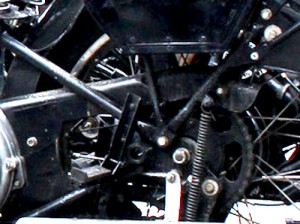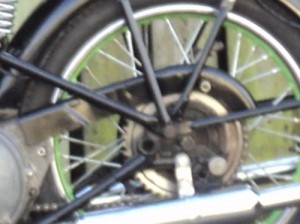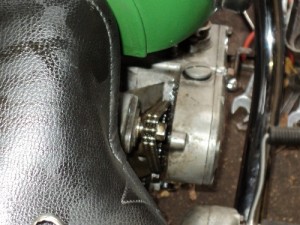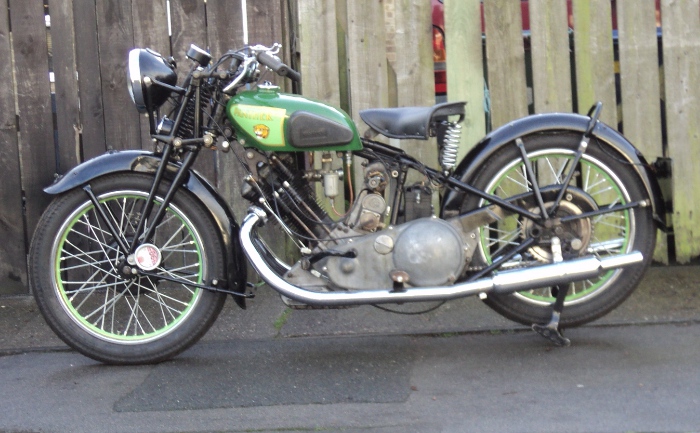Well the last stages are to fit the final drive chain-guard and to set up the dynamo.
As there was no chain guard with the bike when I got her I had to see what I could do.
On checking photo’s of other machines of this period I found that it was a bit of an odd ball in that it had a flare up at the rear end. Needless to say this part is one that is not listed in the Panther Club’s spares scheme so I would have to make do.
As it happens the old lady has a stable-mate, a late model Velocette, and on checking my parts cache for this I found a damaged rear chain guard, it having the rear end almost completely broken away.
On offering it up to the Panther it was immediately obvious that no way would the Velo mountings line up with the Panther’s, not only that but the guard was too long.
Measuring it up soon showed that if I cut the guard at the front mounting bracket it would be the correct length so that got rid of one problem completely and half of the other.
The rear Velo mount is a bracket welded to the guard that picks up onto a mount on the Velo’s rear swing arm, but the Panther has a rigid frame, the mounting lug for the rear of the chain-guard is on the mudguard-stay and would not match the Velo bracket.
But the Panther mount matched onto the guard itself so I decided to just remove the bracket and get a nut welded onto the cover at the correct point, using a set bolt to retain it.
Another snag was where the rear frame stay came across the guard as it needed a recess formed in it to give clearance but a little careful work with a cross-pein hammer soon cleared that problem up.
So after getting things sorted out I went over to have a word with Bob at Specialist Services again.
He did a beautiful job of welding up the cracked rear end of the guard, not only that but he buffed it back smooth again, and then fixed the nut onto the side.
Once I had it back home it was out with the filler to make good the surface and then paint the guard before it was fitted to the bike.
This left me with the dynamo to do.
While it checked out electrically sound, the drive end bearing was a bit rough so it was a case of getting replacement bearings and fitting them, an easy job.
With the new bearings fitted the drive sprocket was put onto its taper on the armature and tightened down.
The dynamo was then slid into its housing and the drive chain slipped into place on the sprockets.
The dynamo was adjusted side to side until the sprockets were in alignment and the chain free play set.
Before connecting the dynamo to the new, solid state, regulator its output needed checking, and to do this it has to be running at normal speed so preparations for this were made.
There are two outputs from the dynamo, one labelled “F” and the other “D” plus a ground connection made through its casing.
The “F” and “D” outputs were connected together and these joined outputs connected to a headlamp bulb, the other side of the bulb being connected to ground.
Now came the acid test, I had to get the motor running for the first time in some thirty years.
So a half gallon of fuel was put into the tank, the tap set to “Reserve” and turned on.
After giving the carburetter time to fill the choke was set to full on, ignition lever to half-way, valve lifter raised and the motor gently turned over several times to prime it.
Ease over compression and give the traditional “long swinging kick” – – Nothing.
Tried again, once again nothing.
So I tickled the float for a couple of seconds, primed her again and then the next effort to start her was met with a vicious kick back – – – AHH, Signs of life! That’s more like it!
Set the advance back a bit more and try again and she was running.
So set the choke to half open, add a bit of advance and then just listen to the noises!
No undue clatters, tappets quiet, all seems as it should be so I shut the throttle and she was ticking over, rather fast but doing it and by now I had the choke off completely so I grabbed a screwdriver and set the throttle stop down a bit then played with it and the pilot air adjuster to get a reasonable tick over, I’ll have to do it properly once I have her thoroughly warmed up but this’ll give a good start point.
So with a feeling of satisfaction of a job well done I shut her down, – – – – and then realised I’d forgotten to check the dynamo output! Typical!.
So I had to fire her up again, only to find that the test light was staying out, the dynamo apparently was not charging so she was shut down again.
Before going any further I checked the bulb was ok using the bikes battery.
As a sidenote here, these old ladies used the old type black, rubber-cased batteries, which were mounted visibly, Panther mounted theirs on top of the rear engine plates, above the gearbox.
To keep the correct period look you can take an old battery of this type, gut it of the old plates and separators to give an empty box and then fit a modern battery inside which is what I have done, in fact to be honest I’m using the one I did previously for the Velo.
There are specialist dealers, such as Burlen , who can supply you with a casing ready modified and already containing a suitable battery.
Anyway, as the dynamo had been standing for so many years it seemed probable that it had lost the residual magnetism it needs to start it charging and that it just needed “flashing”.
To do this I took a lead from the battery positive side having first connected the battery negative to ground.
I fired the bike up again, brought the revs up to a very fast tick over and then just tapped the battery positive lead to the joined dynamo leads. NOTE the connection was literally just made for a fraction of a second and then immediately broken, it was not a permanent connection.
The idea is that the quick power pulse produces a magnetic field in the field coil of the dynamo BUT as the coil only has a low resistance and it is effectively a short-circuit on the battery you cannot leave the connection made.
Once that field is created with the dynamo running, it becomes self re-inforcing and the battery current is not needed, it can in fact cause severe damage if left connected for too long.
This did the trick and with the dynamo charging it was now just a case of connecting it to the regulator, fitting the dynamo chain cover and that was things set for the first ride.
Here’s a look at the old girl in her new clothes ready to go out on the town.






Hello Drew,
We just met on KradRider. I read all the resurrection of your beautiful Panther today, what with the dreadful weather in Brittany!
As I already said on KR what a splendid bike! Your job also is outstanding. Now the drawback is I would want one to restore! Then my KSS600 is not even finished and I also have car’s projects to finish first.
Keep us informed about her Drew please.
Renaud